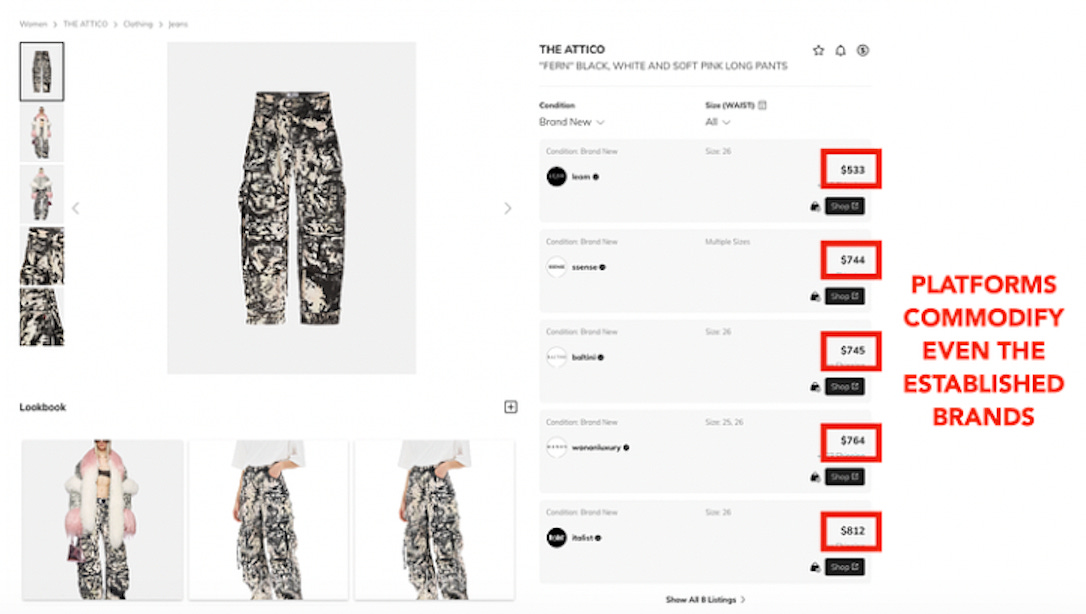Welcome to the Sociology of Business. If you are on the Substack, join the chat and I’m happy to respond to any questions in the chat or comments here. In my last analysis, Hitlist 001, I looked into culture through the lens of aspirational spending. The Sociology of Business is now offering 25% GROUP SUBSCRIPTIONS, make sure to take advantage of it. For sponsorship options, send me an email. Pre-order my new book Hitmakers: How Brands Influence Culture, and find me on Instagram, Twitter, and Threads. With one of the paid subscription options, join Paid Membership Chat, and with the free subscription, join The General Chat on The Sociology of Business WhatsApp group.
Product-led organizations are built around their products. This means that everything that a company does - branding, marketing, distribution, sales, retail, unit economics - speaks to product features: design, fit, signature details, quality, durability, performance, symbolism.
This model is these days exceedingly rare in retail, where companies churn a great number of unremarkable products differentiated only by their brand. Brand-driven product differentiation is a useful scaling mechanism - a brand is an umbrella for the countless product categories and SKUs - but is increasingly inefficient in online marketplaces. Even brands with loyal customers are not immune to commodification.
Catch up on the Sociology of Business:
Winning in second-hand markets
Second hand is the first choice. Desirability and demand for secondary marketplaces is linked to the shift in wealth creation. There is a direct line between the pre-2020 spending frenzy on tourism, luxury fashion, cultural heritage and the arts and the current spending on vintage goods.
The power of secondary marketplaces
Modern wealth capitalizes on the past - of places, objects, institutions, cultural activity and people - and in the stories (histories, heritage, tradition) associated with them. Growth is in reviving past, ascribing it importance through a half-real-half-imagined narrative, and turning it into an investment asset.
On the Internet, price and convenience win - along with the innately recognizable products. Product recognizability is a guarantee of differentiation, and a signifier of identity. L.L Bean Tote, Alpha Industries MA-1, Birkenstocks, Levi’s 501, Crocs, IKEA blue shopping bags, Rimowa luggage, or Hermès Birkin can be counterfeited and copied, but still retain their differentiation and identity.
A product-led organization preserves and enforces this product differentiation. At its core is the clear product segmentation, often in the form of product pyramid, which defines the product universe. Like Marvel Cinematic Universe, product universe has its heroes that can operate individually or together, as well as supporting characters.
Product design focuses on keeping the iconic products - like MA-1 bomber, Birkenstock Arizona or Levi’s 501 - simultaneously classic and fresh. The icons are always in stock, and demand is spurred by archive reissues, product reboots and sequels, special editions, collaborations, and capsules, along with innovation in materials. “Supporting” characters have to be clearly categorized and reflect novelty of the icons. All products need to be part of the same annual narrative.
In addition to icons and collection, there are cultural products here that enrich the universe. They connect different products and convey their benefits. These cultural products are merch - like dust bags in shoe boxes - but also events, exhibitions, content, advertising, customization, or retail experiences.
Organizationally and operationally, this means that product design needs to work closely with brand, creative, and marketing team in order to define the annual narrative, select collaborators or themes for the capsules, decide on which archival items to reissue and which products to reboot. Additionally, the close connection between design, brand, creative, and marketing will ensure the consistent creation of cultural products to enrich the product universe and amplify the iconic product benefits.
Merchandising ensures that the right products are marketed to the right people, in the right retail channels. It works closely with product design on the wear scenarios, anchor products, modules, assortment planning, and the rollout plan. With creative, it works closely on the annual and quarterly narratives, visual merchandising and styling. With retail channels, it works on channel planning, inventory management, cross channel amplification, and distribution segmentation. With marketing, it works on commercial planning, rollout plan, and channel allocation rooted in customer personas.
Prada’s recent strong H1 2024 results are rooted in the considered product universe: “The positive performance was supported by a well-balanced category mix: newness and icons continued to sustain leather goods, while creative dynamism drove ready-to-wear and footwear traction,” noted Patrizio Bertelli, Prada Group Chairman and Executive Director.
Retailers with a considered product universe have a clear knowledge of what percentage of revenue goes to icons, classics, hero products, and the rest of the product portfolio and plan their inventory, channel allocation, marketing and creative accordingly.
Different products in the universe are all potential entry points into the brand. Some of them, like icons innovation, collaborations, special editions, or capsules, lure in new customers. Example is L.L. Bean’s Tote bag, whose sales grew 64% from fiscal years 2021 to 2023. Other products can be used to grow in new markets and/or new categories.
In the product-led organizations, role of merchandising is to be proactive, future-focused, and strategic: to ensure the year-round product relevance through the assortment selection and channel allocation; to secure the cadence of drops and storytelling in each of the channels and across the channels; to create many doors into the product universe; and to ensure that all customer personas are represented in the assortment selection.
Retail covers distribution, channel allocation and amplification, inventory planning, commercial planning, visual merchandising, styling, retail experience, marketing messaging and creative communications. Critical here is to manage inventory and distribution of iconic products, to develop a strong commercial plan around them, and to use product innovation, creative, and cultural products to maintain (and grow) their
Keep reading with a 7-day free trial
Subscribe to The Sociology of Business to keep reading this post and get 7 days of free access to the full post archives.









